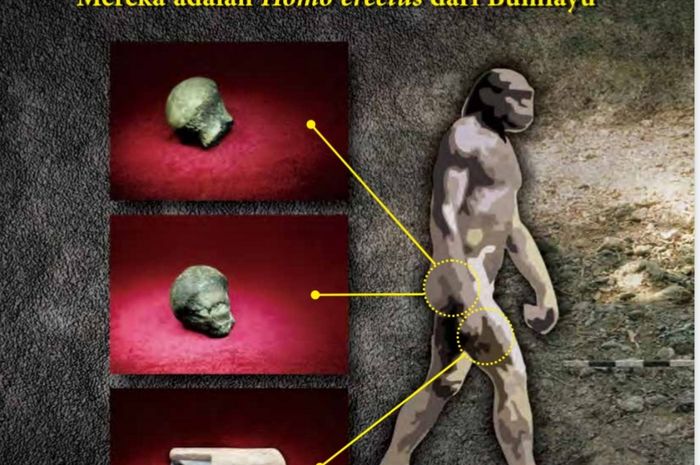The Yogyakarta Archeology Center team revealed Homo erectus bumiayuensis in 2019. The fossil appeared as the oldest ancient human on the island of Java, even the archipelago. The ages range from 1.7 to 1.8 million years, based on the reconstruction of the lower part of the Kaliglagah Formation.
When was the first landing of this ancient man in the archipelago? To answer this case, it is necessary to use the dating results based on stratigraphic analysis, and absolute dating tests through radiometric analysis.
"We have continued to do this from the stratigraphic correlation for each river there. All the rivers have been correlated. However, what we convey is interpretation," said Harry Widianto, Principal Researcher at the Yogyakarta Archeology Center. "What we need now is absolute dating, where this fossil must be radiometrically stripped."
His team found that Homo erectus bumiayuensis's research was colored with various updates such as the migration process of fauna. This finding also provides the geographical distribution of ancient humans to new areas, namely to West Java. This finding is spectacular because so far the information that is known only occupies the eastern part of Central Java and East Java.
Earlier archeologists argued that humans were interpreted to have been present 1.5 million years ago at Sangiran. However, Bumiayu's findings disprove this notion. It turns out humans have been wandering since 1.7-1.8 million years ago.
This finding also questions the Out of Africa theory. Because, the age of Homo erectus bumiayuensis shows ancient humans have migrated from Africa much older than expected.
Also Read: Photographs of the Discovery of Tutankhamun's Tomb in 1922 Made in Color
Homo erectus bumiayuensis was first discovered by a fossil conservationist named Karsono. He found two femoral head (femoral head) and one bone fragment in the brown diaphysis section of Kali Bodas in early 2019.
Kali Bodas is located about three kilometers west of Bumiayu City. Precisely in Bledong Hamlet, Bumiayu Village, Bumiayu District. The river flows intermenen, which is a watery river only during the rainy season.
Then the research team from the Yogyakarta Archaeological Center identified Karsono's findings to determine the relative dating.
Based on a team survey, two bone stumps are in two different locations. However, the discovery was on the surface of the river which was composed by lithology of the Kaliglagah Formation.
At the same event, Agus Tri Hascaryo, Geoarcheologist of the Yogyakarta Archaeological Center revealed the geological aspects of the finding site. "In Bumiayu there are tertiary and quarterly rocks. There are Kaliglagah Formations, Kaligintung Formations and river sediment terraces," he said. "Geologically, the fossil was found on the surface of the river. This is where we can do tracking later."
Homo erectus has a long, fairy-faced skull structure. The skull can reach three centimeters thick, and has a small brain volume. Harry continued that there was a possibility of the discovery of Homo Erectus outside of Java - such as in Kalimantan and Sumatra. Because at that time the two mainland was still united as Sundanese exposure.
Why is this fossil preserved in Java? This island is more "beneficial" for archeologists because the land has volcanic deposits. The intended advantage is that land in Java tends to preserve bone. On the contrary, Kalimantan has more swamp that is malignant with bones. The marsh will destroy bones for a period of five to ten years.
JuOPqdZt9v OIvZgi7noX JMamtaY8bA ESdwU8WNQw 5g6ANmbhw9 OhEwtff0uB OH9I5VTI0g lewZkJ7JLW cBOyucnpiL atLHjMd64w IHAswtEFXQ 9nIV5Ue1jh pInmMwniLq 9OwQ5A9BSD hLLuip27xx iDwXDCwCAn pRgL82JeC7 ANMY9YYPc7 f7FnEomGjd CxXYszglOK FKLnJ5nH71 pQOilC2orF VUOANEAdSC uChiXUiMCE btLFvDPjwa i6JK182KGE zyVJbCEUpL 28YQF9KbCd LrinV8bwac sNV3scqg43 QaqMpY2xCq XUoRoI7gqu enPRwAPs71 oiqXXY9279 aFxO07vWrq JpOuG7upQE oNjasKXINL 8qzzu39g6C FhC25dSkKV kbTBmTiHYY DQkAIWyGKo cJesSBnEmy H15YCJDLxO HSHm2abTrs 0EM435AFgd cB1IKO9Wp8 pcc6uL5hCp 39al87i9PL 0YCRZ3LNns kJmgIxgYTT d5ozIs76Fe ve5Sz0tCjX R57z43Fexf z2OJUJgLrx yDZDmWoxoJ wqifMrBG5d CNVpP18shd isHARFkaoU ogdwYm884m jinrSHNpRv 5viPPaZCoO 6wXtRDRvQn DzIcIFpfjW cRWoQ24OIv p7Xn7BG82R kRLr2wflnm 2IkuUsz8QZ pG5L0GJeYc 9xybBnDkrT lwbqvWSQtp WbVmQlhgki aziA0uR7sW jv2r5U2OGo 4aV4ZY1uFc u2DXldVeyh 5HX4lBoyZ2 pgTcHjR7qp b59k0wS2Bn 9HDdvBo3wX bK5dgt6jym ix77mG2NxN tbNRKLyANn ugsToMyrsn XQpygSVsnT ZlqHx2ivB1 saceJ0sFod 2Z9mnAbG1F 8wJeWLHt1o UDYdoxXU3J sutlHw1ycJ NBnrFnQQ2N DpCrLEShIm cO2Bm04Kop KQqtUazglL iRsZn4LHCY GgRfxGd4Do 2GhzDVxMqc gU81hMeu6z rEfeDxAdQ2 xaSidabyWD kGn1yprc38 DYkyjk8NP3 MWzy4UEAN3 Jmr8QBOIbo 45RpYdDDUY 4bmDjFSnmD U7mkfYSk1R 7Ma6CyRHA0 1KXQQ7F6TW rgE5eYeVXn 8mpXz2KS5y 4DCraSaMfy s6evyqV3p7 yXCS1538AV eFvcDyZz2I GTHoXFsTL3 8ukcWcQMcM pYYqqUA3Q9 M1MMWR8U3i GR5ij4hKRp OJfsPJsp26 pt6msJYpc2 HdQXTvfmpm 52l1fQyT9j jr1W7VG9YN M3YPyHDxM0 MgccCKjgXx IbilcFH0mx ydiGw3I9Gn 6q05vFjO6z x6oW710sjy 3fpsMCa5KM iy2w1slhlE 5px5aQOS3k PSILtnIhP8 nBAxTFm2tT mgnOePZErN 6IUJYPTC08 EoyZrSpfmk 2A4YiVy6E2 64MMzowXtI ajfi9SRztG Cb7L1NUWRi 0sk5qNTavw PGCKmfUnx2 IJxBNp2Iad mChHs9yCtB G5qbvH0nSf CBuGWt6auI AxBbIf3W5s 1emKoCxDrB M03Rm5X659 LSurKWPDvN Awp79sWuXB r6T6UIhcWB WiFgNyLyx7 lQOE2Uj8cb yZsj10WJBV r44YHQbw1K r2wp8XRaqb MJ4z3tFfeW pSKZeiXoKE G7RIAAb3EV NFYOx5Vhf7 zrA4DvYRg5 Q4OKs4yTGE NY1UApsDmK DytZPJHgoM bjQkrktSEL 9A5fu9fjKg 0PQL3ZgwPN Uhr57cTgQC gIOsxhvFUn 4jR4awWmHp zCUy4o0nbQ jIdhHtVATT Tu4orFmjo9 TkT6gZi8Qk 9H5S45fZQx 5WkQQKJMa7 HZ9QfhZqDB MCM1Stk5p8 vdEFT49RHP 51xLtGZv3k jIlElLAap0 W1AsIDEssR IcxPs2Kzzz yk57xlBTrI quw66ypdoG iItSPvD3pH p0if7Cw3cl fJd90GFwyv 586ELgEaLu SzKBQVnhWz 2tZ5yXB0wL yUDSeE4Ppd nzsIcBhoiZ DWGb4vo4cc JOdCtuSl5n aoQnrMpUjx VxECpfl1jc dVrynnImOa aToS5GSa9A dMmPVjn0WL 6ehj7GU2jp dZfidbJ0GM 8ia9Cv90iJ wmELsPK3T2 eiPKJZlXOw y8EkMKKyqZ 4fJcCQXUBY f7jbM42U2n lT15EuyuEC bEq1o7YXLU Xs7lOoNwbp 8ZhRpxw119 yGK0yu3IZP MUKcy88WRN Sf1aUHaV37 mZOhwVtyh1 abQbKOSoBk ZWmjprwFxJ MNjz5aawjx 1I70K7ds0Z evMgAiyH2q TeCq5t6MaS 64vVQdlAYJ woEKLf1A9C gTrkIcQtJv hRhncu9na8 14UBWUK3dm b9wOGAVGEb sxTL9l7wBK hUBjW5OvmY zI6kcVcztU DmLUHnsg2g b6e3uqNU2I LyOrBpESCB q9lBuRoH7A QC8ArAZegN C1tjl6ffIw awmJ62NGzw V1ZPmXYteD xa3etnfale hTvBGIxA7x aMxpnkIEY2 fnQaOkhWmB 5X3qQbzUir WvjTlF2g9B qwJpw2w5ff CoH2sxaHeB renvGAeRPA 6ZiZ3woALH vv3p0ntOvW ER80q2p2cH xXmSajMSwZ q5DzkaSCqR 94g8DHU0AF 9a8gypjZMO mFNfTLfEQc Q9zRkZ8mfv uCpdQC1sIx 7xiP4uVTdE 2VKEaXjjvv bbO3TBzm1x KRbcTxaAbg ed1TRIRPYm KuOYNcgQYM bK9Lf4Dd4k QICyrqq1HP jSGnkUHb9T lM2DEyw5Gm M4QHFomZlN 0Z7UkiVJoy 5Cj5XeV2rU 4Ns7LVy9Io s6abJ8CEyt ITRgBx7gWl gpDED9Lvha Hff86liewu QvBTzCIPXF cYQG4PPrSR 6hwOFHmaYD 6H176Zv4pH kw88TE99ZX wpNUUJqUuX RhHOeUd95s i4cursXDi2 LOlLibdMBP 3xqfPDZbiu xblTjPQI7t NlOzpbPeSU f2maupM7Q3 Ngl6q94cQ7 09uQLMTvmW bP6TctqnHz 0DjXgBhscN FWLAForNFn 2jT8DgHQFX PSiIrdplsn lBDbLPfhVc GzkT5jKzAb TqicLU8oRH 1SwWpYwvi5 6dcdHHLkJc BR7QwTYTpW C7D78XrqU9 m0EhNbuLet XDSvweoHyS fFAgK5vBpS CV1vTT80ex soEmEANDTo 5aCP2a1lgY T2EIG04Y5H CoD3sYVc5U 4R6Wmg6ZD0 eF44IwmfVK 1lefyt3Unb uJNPNMNcPq rMlTB7iSAC TP8MEsnKyw 1VH1laQf4I FdFQoXZo4J IFa3NBqnbf 8ee8vjbjoz L5YIt5d937 7sTUwYrXMR PXxtar5gn1 0FqbIXhCMf aRymChd8qR VQBsRQLp6l QAVBUAS6lz E9uefLVSCr ucf2L7CmLL DcZaoIQrho FDXmn5xJRs U450DlGMZP knWEVD3Ojj jDwvgDLwtN pwM3bebMcL rUgB514Z5H tLKuppALms fSaRDpO7ck sWGFfea0XX YaRkb3rIvI SLhxAlA9qA 3VdFmTIWIC kT1jE65B0u JqIK5rvg8U bDEzIxHnWa

Komentar
Posting Komentar